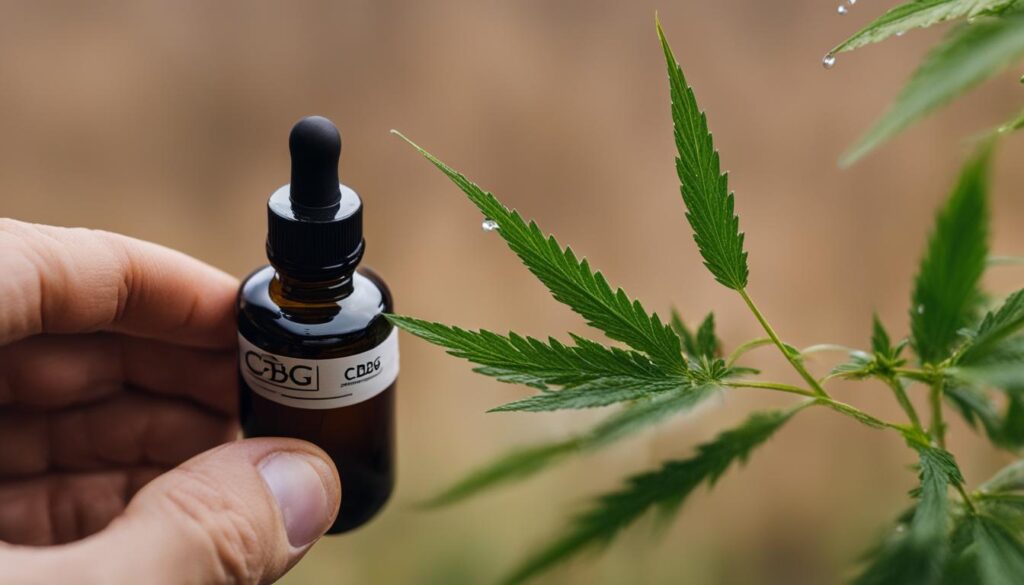As the popularity of cannabinoids continues to grow, one cannabinoid that is gaining attention is CBG, short for cannabigerol. CBG is known as the “mother cannabinoid” because it serves as the precursor to other cannabinoids like THC and CBD. In this guide, I will provide you with an overview of CBG, its potential benefits, how it compares to other cannabinoids, and much more.
Key Takeaways:
- CBG, or cannabigerol, is a beneficial cannabinoid found naturally in the cannabis plant.
- Unlike THC, CBG does not produce psychoactive effects, making it safe and non-intoxicating.
- CBG may have antibacterial, anti-inflammatory, and neuroprotective properties.
- When combined with other cannabinoids like CBD, CBG can enhance therapeutic effects.
- CBG can be consumed in various forms such as oil, isolate, or extracted from the hemp plant.
What is a Cannabinoid?
Cannabinoids are compounds found in nature, including in the cannabis plant. The human body also produces its own cannabinoids, called endocannabinoids, which interact with the body’s endocannabinoid system (ECS). The ECS consists of receptors and organs that help maintain chemical balance, or homeostasis, within the body. When cannabinoid compounds interact with the receptors in the ECS, they can affect functions related to mood, sleep, pain perception, and appetite, among others.
The cannabis plant produces over 100 different cannabinoids, with THC and CBD being the most well-known. CBG is another important cannabinoid that interacts with the ECS and has unique effects on the body.
What is the Endocannabinoid System?
The endocannabinoid system (ECS) is a complex network of receptors, enzymes, and endocannabinoids that play a crucial role in maintaining balance within the body. It helps regulate various physiological processes, including mood, sleep, pain perception, and appetite. The ECS consists of two primary receptors, CB1 and CB2, which are found throughout the body in different concentrations. CB1 receptors are primarily located in the brain and central nervous system, while CB2 receptors are more abundant in the immune system and peripheral tissues.
When cannabinoids, such as CBG, interact with these receptors, they can modulate the activity of the ECS and influence these physiological processes. This interaction helps promote homeostasis and overall well-being.
| Cannabinoid | Receptor Interaction | Effects |
|---|---|---|
| CBG | Interacts with CB1 and CB2 receptors | Potential antibacterial, anti-inflammatory, and neuroprotective properties |
| THC | Binds primarily to CB1 receptors | Produces psychoactive effects, such as euphoria and altered perception |
| CBD | Modulates the interaction of other cannabinoids with CB1 and CB2 receptors | Non-intoxicating and may have therapeutic effects, such as reducing anxiety and inflammation |

An Introduction to CBG
CBG, or cannabigerol, is a lesser-known cannabinoid found naturally in the cannabis plant. It plays a crucial role as the precursor to other cannabinoids, earning it the nickname “mother cannabinoid.” While CBG is present in small quantities in all cannabis plants, it is most abundant in young plants. CBG is produced within the trichomes, which are tiny hairs on the plant that contain the highest concentrations of cannabinoids.
The production of CBG begins with CBG-a, the acidic form of CBG. As the cannabis plant matures, CBG-a breaks down and transforms into other cannabinoids, such as THC and CBD. This transformation occurs throughout the plant’s life cycle, with CBG being the first cannabinoid that can be detected in the plant. The unique production process of CBG within the trichomes highlights its importance and potential therapeutic benefits.
CBG Production Process
The production of CBG within the cannabis plant involves the following steps:
- CBG-a synthesis: The cannabis plant produces CBG-a as the initial cannabinoid.
- Enzymatic reactions: Over time, enzymes within the plant break down CBG-a and convert it into other cannabinoids.
- CBG conversion: As the plant matures, CBG-a content decreases, and CBG content increases.
- Formation of other cannabinoids: CBG breaks down to form other cannabinoids, such as THC, CBD, and CBC.
This intricate production process highlights the potential of CBG and its role as a precursor to other cannabinoids. While CBG is still being studied, it shows promise in offering unique therapeutic effects that differ from other cannabinoids like THC and CBD.

The Potential of CBG
The potential benefits of CBG are still being explored, but early studies suggest that this cannabinoid may have antibacterial, anti-inflammatory, and neuroprotective properties. CBG may also offer relief from conditions like anxiety, muscle strain, glaucoma, and pain. However, it is important to note that more research is needed to fully understand the extent of CBG’s therapeutic effects and its specific applications.
As the understanding of CBG grows, it holds promise as an important player in the world of cannabinoids. Its unique production process and potential benefits make it an intriguing cannabinoid to watch as further research unfolds.
Potential Benefits of CBG
CBG, also known as cannabigerol, has shown promise in various areas of potential health benefits. While research is still ongoing, preliminary studies suggest that CBG possesses antibacterial properties, making it a potential candidate for treating bacterial infections. Additionally, CBG exhibits anti-inflammatory properties, which could provide relief for conditions such as inflammatory bowel disease and irritable bowel syndrome.
One of the notable benefits of CBG is its potential in anxiety relief. CBG may increase serotonin levels in the brain, helping alleviate symptoms of anxiety. Moreover, CBG has been identified as a muscle relaxant, making it potentially beneficial for individuals dealing with muscle strain or pain.
CBG has also shown potential in providing relief for glaucoma by reducing intraocular pressure. This could help manage the condition and prevent further damage to the optic nerve. Furthermore, CBG’s potential as a cancer treatment is currently being explored, with studies suggesting that it may inhibit the growth of cancer cells. It’s important to note that more research is needed in these areas to fully understand CBG’s effects.
While these potential benefits are exciting, it’s crucial to remember that CBG research is still in its early stages. More studies are needed to confirm and understand the full scope of CBG’s therapeutic properties. Individuals interested in exploring CBG as a potential treatment option should consult with a healthcare professional for personalized guidance.
Comparing CBG to CBD and THC
When it comes to cannabinoids, CBG, CBD, and THC are often discussed in comparison to each other due to their unique properties and effects on the body. Let’s take a closer look at how these cannabinoids differ:
The Molecular Structure
One of the key differences between CBG, CBD, and THC lies in their molecular structures. CBG, or cannabigerol, has a different chemical makeup compared to CBD and THC. This difference in structure contributes to the varying effects that these cannabinoids have on the body.
Psychoactive Effects
While THC is renowned for its psychoactive effects, CBG and CBD do not produce the same intoxicating high. THC binds directly to the CB1 receptors in the brain, resulting in the psychoactive experience. On the other hand, CBG and CBD have a minimal binding affinity for these receptors, meaning they do not induce the same mind-altering effects.
Abundance and Availability
CBG is typically found in lower quantities compared to CBD and THC in mature cannabis plants. However, growers are now developing strains that are specifically bred to contain higher levels of CBG. As a result, CBG-rich products are becoming more accessible to consumers, offering a wider range of options for those seeking its potential therapeutic benefits.
| Cannabinoid | Psychoactive Effects | Abundance |
|---|---|---|
| CBG | No | Lower quantities in mature plants, but increasing availability |
| CBD | No | More abundant in certain hemp strains |
| THC | Yes | Abundant in cannabis strains |
It’s important to note that CBG, CBD, and THC all have their own unique therapeutic potential. While more research is needed to fully understand the benefits of CBG, it shows promise as a therapeutic compound that can be used in conjunction with other cannabinoids to enhance their effects. As the scientific community continues to explore the potential of these cannabinoids, we can expect even greater insights into their individual and synergistic benefits.
Dosing CBG
When it comes to dosing CBG, several factors need to be considered. These include weight, height, overall health, and previous cannabis product usage. It’s essential to find the right balance to achieve optimal results with CBG.
It is recommended to start with a small amount of CBG and gradually increase the dosage until the desired effects are achieved. This method allows for individual tolerance and sensitivity to be taken into account. Keeping a journal to track the effects and side effects of each dose can be helpful in finding the ideal dosage.
As a general guideline, starting with a daily dose of 2.5 mg of CBG is a common approach. However, it is important to note that everyone’s endocannabinoid system is unique, and individual responses may vary. Consulting with a healthcare professional or cannabis advisor can provide further guidance on finding the right CBG dosage for specific needs.

The Numerous Ways to Take CBG
When it comes to incorporating CBG into your routine, there are several options to choose from. Whether you prefer edibles, tinctures, or other products, there is a CBG option that suits your individual needs and preferences.
CBG Edibles: Edibles infused with CBG offer a convenient and discreet way to consume this cannabinoid. From gummies to chocolates, there are a variety of tasty treats available that contain CBG. These edible products provide a consistent and measured dose, making them easy to incorporate into your daily routine.
CBG Tinctures: Tinctures are liquid extracts that can be taken sublingually or added to food and beverages. CBG tinctures are often combined with carrier oils like MCT oil, which helps facilitate absorption. Tinctures allow for precise dosing and provide a quick and efficient way to experience the potential benefits of CBG.
CBG Products: In addition to edibles and tinctures, there is a wide range of CBG products available on the market. These include capsules, topicals, and even CBG-infused beverages. Each product offers a unique way to incorporate CBG into your wellness routine, allowing you to choose the format that best suits your lifestyle.
When purchasing CBG products, it is important to look for Certificates of Analysis (COAs) from reputable manufacturers. These COAs provide third-party lab testing results, ensuring that the stated CBG content is accurate and that the product is free from harmful contaminants.

| CBG Product | Description |
|---|---|
| CBG Edibles | Delicious treats infused with CBG, available in various flavors and forms. |
| CBG Tinctures | Liquid extracts that can be taken sublingually or added to food and beverages for easy consumption. |
| CBG Capsules | Precisely measured capsules that offer a convenient way to incorporate CBG into your routine. |
| CBG Topicals | Topical creams, lotions, and balms infused with CBG for targeted application and potential relief. |
| CBG Beverages | Drinks infused with CBG, providing a refreshing and enjoyable way to consume this cannabinoid. |
Whichever form of CBG you choose, it’s important to consult with a healthcare professional or cannabis advisor to determine the best option for your specific needs. They can provide guidance on dosing and help you find the right CBG product for you. Remember, everyone’s experience with CBG may vary, so it’s important to start with a low dose and gradually increase as needed.
Find CBG at Your Local Dispensary
If you’re ready to explore the potential benefits of CBG, look no further than your local dispensaries. These establishments are the go-to places for finding strains high in CBG that can suit your individual needs. Whether you’re seeking CBG flower or other products that combine CBG with other cannabinoids, dispensaries offer a range of options to choose from.
When you visit a CBG dispensary, you can expect knowledgeable staff members who are well-versed in the world of cannabinoids. They can guide you in selecting the best CBG strains based on your preferences and goals. Whether you have questions about dosages, consumption methods, or the different therapeutic effects of CBG, the dispensary staff is there to help.
To ensure a positive experience, it’s always a good idea to research local dispensaries beforehand. Check reviews and ratings to find reputable establishments that prioritize quality and safety. You can also inquire about Certificates of Analysis, which provide information on the CBG content and ensure that the products meet the necessary standards.
So, why wait? Head to your local CBG dispensary and embark on your CBG journey today. Whether you’re a seasoned cannabinoid user or just starting, the world of CBG awaits you at your neighborhood dispensary.
FAQ
What is CBG?
CBG, short for cannabigerol, is a beneficial cannabinoid found naturally in the cannabis plant. It interacts with the body’s endocannabinoid system (ECS) to promote homeostasis and potentially provide a range of health benefits.
How does CBG differ from CBD and THC?
CBG, CBD, and THC are all cannabinoids, but they have different molecular structures and effects on the body. CBG interacts directly with the body’s CB1 and CB2 cannabinoid receptors, while CBD modulates the interactions of other cannabinoids with these receptors. Unlike THC, CBG does not produce psychoactive effects.
What are the potential benefits of CBG?
Current studies suggest that CBG may have antibacterial, anti-inflammatory, and neuroprotective properties, among other potential benefits. It may also have anxiety-relieving effects, serve as a muscle relaxant, and provide potential benefits for conditions like glaucoma and cancer.
How do I determine the appropriate CBG dosage?
Factors such as weight, height, overall health, and previous cannabis product usage should be considered when determining the appropriate CBG dosage. It is recommended to start with a small amount and gradually increase the dosage until desired results are achieved. Keeping a journal to track effects and side effects can be helpful.
In what forms can CBG be consumed?
CBG can be obtained in various forms such as oil, isolate, or extracted from the hemp plant. It can also be consumed through edibles and tinctures, although availability may vary. CBG is often combined with other cannabinoids like CBD in therapeutic products for enhanced effects.
How can I find CBG at my local dispensary?
To find strains high in CBG, individuals can visit local dispensaries. The knowledgeable staff can provide guidance and help identify the best CBG options based on individual needs. Strains high in CBG can be used in various forms such as flower or other products that combine CBG with other cannabinoids.
Author Profile

Latest entries
 BlogFebruary 20, 2024I Just Found the Ultimate Clog-Free Vape Cartridge! (Yes, They Exist!)
BlogFebruary 20, 2024I Just Found the Ultimate Clog-Free Vape Cartridge! (Yes, They Exist!) BlogJanuary 16, 2024In the Clouds with Creativity: A Blunt Encounter with Montreal’s Fluid Art Maestro
BlogJanuary 16, 2024In the Clouds with Creativity: A Blunt Encounter with Montreal’s Fluid Art Maestro BlogDecember 25, 2023Sativa: Enhancing Outdoor Adventures
BlogDecember 25, 2023Sativa: Enhancing Outdoor Adventures BlogDecember 25, 2023Enhancing Memory with Sativa
BlogDecember 25, 2023Enhancing Memory with Sativa





